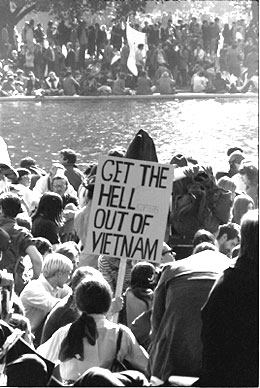|
Digital
History>eXplorations
|

|
President
Lyndon B. Johnson addressing crowd in Indianapolis, Indiana,
07/23/1966,
LBJ Library photo by Yoichi R. Okamoto |
Protesting
the Vietnam War: The March on the Pentagon, 10/21/1967,
LBJ Library photo by Frank Wolfe |
Between
1945 and 1954, the Vietnamese waged an anti-colonial war against
France, which received $2.6 billion in financial support from
the United States. The French defeat at the Dien Bien Phu was
followed by a peace conference in Geneva, in which Laos, Cambodia,
and Vietnam received their independence and Vietnam was temporarily
divided between an anti-Communist South and a Communist North.
In 1956, South Vietnam, with American backing, refused to hold
the unification elections. By 1958, Communist-led guerrillas known
as the Viet Cong had begun to battle the South Vietnamese government.
To
support the South’s government, the United States sent in
2,000 military advisors, a number that grew to 16,300 in 1963.
The military condition deteriorated, and by 1963 South Vietnam
had lost the fertile Mekong Delta to the Vietcong.
In
1965, Johnson escalated the war, commencing air strikes on North
Vietnam and committing ground forces, which numbered 536,000 in
1968. The 1968 Tet Offensive by the North Vietnamese turned many
Americans against the war.
The
next president, Richard Nixon, advocated Vietnamization, withdrawing
American troops and giving South Vietnam greater responsibility
for fighting the war. His attempt to slow the flow of North Vietnamese
soldiers and supplies into South Vietnam by sending American forces
to destroy Communist supply bases in Cambodia in 1970 in violation
of Cambodian neutrality provoked antiwar protests on the nation’s
college campuses.
From
1968 to 1973 efforts were made to end the conflict through diplomacy.
In
January 1973, an agreement reached and U.S. forces were withdrawn
from Vietnam and U.S. prisoners of war were released. In April
1975, South Vietnam surrendered to the North and Vietnam was reunited.
CONSEQUENCES:
1.
The Vietnam War cost the United States 58,000 lives and 350,000
casualties. It also resulted in between one and two million
Vietnamese deaths.
2.
Congress enacted the War Powers Act in 1973, requiring the president
to receive explicit Congressional approval before committing
American forces overseas.
|
